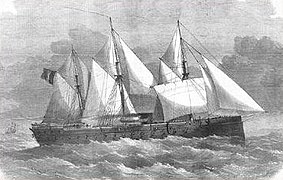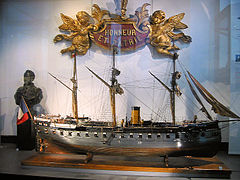French ironclad Gloire
This article needs additional citations for verification. (January 2014) |
 Gloire anchored, 1869
| |
| History | |
|---|---|
| Name | Gloire |
| Namesake | Glory |
| Laid down | 4 March 1858 |
| Launched | 24 November 1859 |
| Completed | August 1860 |
| Stricken | 1879 |
| Fate | Scrapped, 1883 |
| General characteristics | |
| Class and type | Gloire-class ironclad |
| Displacement | 5,618 t (5,529 long tons) |
| Length | 78.22 m (256 ft 8 in) |
| Beam | 17 m (55 ft 9 in) |
| Draught | 8.48 m (27 ft 10 in) |
| Depth of hold | 10.67 m (35 ft 0 in) |
| Installed power | |
| Propulsion |
|
| Sail plan | Barquentine rigged |
| Speed | 13 knots (24 km/h; 15 mph) |
| Range | 4,000 km (2,500 mi) at 8 knots (15 km/h; 9.2 mph) |
| Complement | 570 officers and enlisted men |
| Armament |
|
| Armour |
|
The French ironclad Gloire ([ɡlwaʁ], "Glory") was the first ocean-going ironclad, launched in 1859. She was developed after the Crimean War,[1] in response to new developments of naval gun technology, especially the Paixhans guns and rifled guns, which used explosive shells with increased destructive power against wooden ships. Her design was also influenced by the Anglo-French development of ironclad floating batteries to bombard Russian forts during the same war.
Design and description
[edit]Gloire was designed by the French naval architect Henri Dupuy de Lôme as a 5,630-ton broadside ironclad with a wooden hull. Her 12 cm-thick (4.7 in) armour plates, backed with 43 cm (17 in) of timber, resisted hits by the experimental shooting of the strongest guns of the time (the French 50-pounder and the British 68-pounder) at full charge, at a distance of 20 metres (65 ft).
Her maximum speed was 13.1 knots but other reports suggested no more than 11.75 knots had been attained and that 11 knots was the practical maximum.[2]
As was common for the era, Gloire was constructed with sails as well as a steam-powered screw. The original rigging was a light barquentine rig providing 1,096 sq. m (11,800 sq. ft) of surface area. This was later increased to a full rig providing 2,508 sq. m (27,000 sq. ft) of surface.[3]
Service
[edit]This section needs expansion. You can help by adding to it. (January 2014) |
Gloire was launched at the arsenal of Mourillon, Toulon, on 24 November 1859; and entered service in August 1860. She was eliminated from the French fleet registry in 1879, and scrapped in 1883.
The ship underwent preliminary trials in June 1860 with official trials on 20-21 of August, where she achieved 13.5 knots. In September of that year, she escorted the imperial yacht Aigle carrying Emperor Napoleon III to Algiers. During a storm on the return voyage, the Gloire was the sole escort able to remain with the Aigle. On 12 November, Gloire began comparative trials with the Algésiras, culminating in a trial report on 30 March 1861.[4]
Importance in naval history
[edit]As the first ocean-going ironclad, Gloire rendered obsolete traditional unarmoured wooden ships-of-the-line, and all major navies soon began to build ironclads of their own.
Gallery
[edit]-
Photograph of Gloire, circa 1860, at the Musée de la Marine, Paris.
-
The launch of Gloire.
-
Gloire sailing, 19th century print.
-
Scale model of Gloire at the Musée de la Marine.
-
Couronne, near sister-ship of Gloire after it was rebuilt.
Notes
[edit]- ^ The Battle of Sinop at the start of the war convinced the world's naval powers that wooden warships could not withstand the new weapons.
- ^ Wells, John (1987). The immortal Warrior Britain's First and Last battleship. Kenneth Mason. p. 46. ISBN 0-85937-333-9.
- ^ Jackson, Robert (2010). Warships Inside Out. San Diego, CA: Thunder Bay Press. pp. 10–15. ISBN 978-1-60710-109-3.
- ^ Roberts, Stephen S. (2021). French warships in the age of steam, 1859-1914: design, construction, careers and fates. Barnsley: Seaforth Publishing. ISBN 978-1-5267-4533-0.
Bibliography
[edit]- de Balincourt, Captain & Vincent-Bréchignac, Captain (1974). "The French Navy of Yesterday: Ironclad Frigates, Part I". F.P.D.S. Newsletter. II (2): 12–15, 18. OCLC 41554533.
- Campbell, N. J. M. (1979). "France". In Chesneau, Roger & Kolesnik, Eugene M. (eds.). Conway's All the World's Fighting Ships 1860–1905. Greenwich: Conway Maritime Press. pp. 283–333. ISBN 0-8317-0302-4.
- Gardiner, Robert, ed. (1992). Steam, Steel and Shellfire: The Steam Warship 1815–1905. Conway's History of the Ship. London: Conway Maritime Press. ISBN 1-55750-774-0.
- Gille, Eric (1999). Cent ans de cuirassés français [A Century of French Battleships] (in French). Nantes: Marines. ISBN 2-909-675-50-5.
- Jones, Colin (1996). "Entente Cordiale, 1865". In McLean, David & Preston, Antony (eds.). Warship 1996. London: Conway Maritime Press. ISBN 0-85177-685-X.
- Roberts, Stephen S. (2021). French Warships in the Age of Steam 1859–1914: Design, Construction, Careers and Fates. Barnsley, UK: Seaforth Publishing. ISBN 978-1-5267-4533-0.
- Roche, Jean-Michel (2005). Dictionnaire des bâtiments de la flotte de guerre française de Colbert à nos jours [A Dictionary of French Warships from Colbert to Today] (in French). Vol. I: 1671 – 1870. Group Retozel-Maury Millau. ISBN 978-2-9525917-0-6. OCLC 165892922.
- Silverstone, Paul H. (1984). Directory of the World's Capital Ships. New York: Hippocrene Books. ISBN 0-88254-979-0.






